Book contents
- Frontmatter
- Dedication
- Contents
- Preface
- 1 Introducing lunar imaging
- 2 Choosing your imaging equipment
- 3 Adapting your imaging device to the instrument
- 4 Tuning your telescope for lunar imaging
- 5 Wide-field lunar imaging
- 6 High-resolution lunar imaging
- 7 Essential image processing
- 8 Advanced image processing
- 9 Making 3D lunar images
- 10 Measuring and identifying lunar features
- 11 Photogenic features of the Moon
- 12 Naming, archiving, printing, and sharing lunar images
- Appendix 1 Maps of the Moon, the Lunar 100, and other targets
- Appendix 2 Webpages, books, and freeware for the Moon
- Appendix 3 Figure data
- Index
9 - Making 3D lunar images
Published online by Cambridge University Press: 05 September 2016
- Frontmatter
- Dedication
- Contents
- Preface
- 1 Introducing lunar imaging
- 2 Choosing your imaging equipment
- 3 Adapting your imaging device to the instrument
- 4 Tuning your telescope for lunar imaging
- 5 Wide-field lunar imaging
- 6 High-resolution lunar imaging
- 7 Essential image processing
- 8 Advanced image processing
- 9 Making 3D lunar images
- 10 Measuring and identifying lunar features
- 11 Photogenic features of the Moon
- 12 Naming, archiving, printing, and sharing lunar images
- Appendix 1 Maps of the Moon, the Lunar 100, and other targets
- Appendix 2 Webpages, books, and freeware for the Moon
- Appendix 3 Figure data
- Index
Summary
Three-dimensional anaglyph
A 3D anaglyph is a stereoscopic image, formed of images taken from two slightly shifted viewpoints. The differences in perspective between the two images are encoded and represented in cyan and red, respectively. To recreate the feeling of stereoscopy, one has to use cyan and red eyeglasses. Basically, the most obvious way to make a lunar anaglyph is to image the Moon from two sites several thousand kilometers apart at the same time. This has been done successfully by a few amateurs. Another way is to exploit the librations. It is normally not possible to wait for the Moon to rotate between two shots, because of the continuous evolution of its phase, bringing unwelcome variations in illumination of the topography, but the phase is less pronounced near the poles, as we can see at
http://www2.lpod.org/wiki/August_11,_2008
Three-dimensional anaglyph of the Moon
Yuri Goryachko, Mikhail Abgarian, and Konstantin Morozov (Belarus) imaged the region containing the Bailly and Hausen craters twice in 2008 (June 27 and July 25) with a 230-mm Santel Mak, a near-infrared filter, and a Unibrain Fire-i 702 camera (Figure 9.1). They assembled the mosaics to create a stunning 3D anaglyph with the help of librations (Figure 9.2).
“Astronomy has been our favorite hobby since childhood,” Mikhail explains. “Yuri and Konstantin began film astrophotography prior to forming our group in 2007. Our main instrument, a Santel, 230-mm Maksutov–Cassegrain, was replaced in 2013 by a 360-mm Klevtsov–Cassegrain from the same manufacturer; only a single instrument was built. The Moon has always been one of the most interesting targets for us – this seemingly unchanging and boring object actually gives ample space for experiments. In addition to ‘standard’ shooting of lunar landscapes, our particular passions are full Moon mosaics and color images. This material collected for a long time allows us to obtain stereo images. For now our main goal is to realize mosaics for all phases at prime focus of the new telescope. Our dream is to create a mosaic of the full Moon with a focal length of 8–10 meters.”
Mikhail, Yuri, and Konstantin's images have been published several times in LPOD and Sky & Telescope. They have a web site at www.astronominsk.org/index_en.htm.
- Type
- Chapter
- Information
- Shoot the MoonA Complete Guide to Lunar Imaging, pp. 241 - 252Publisher: Cambridge University PressPrint publication year: 2016



